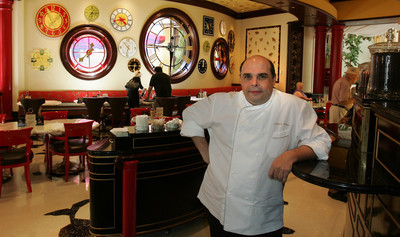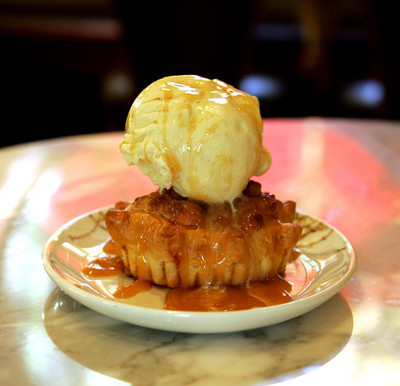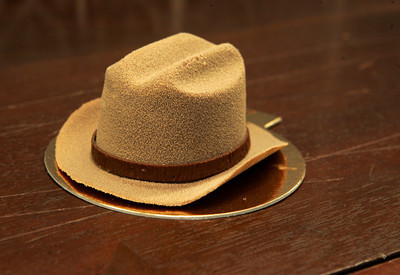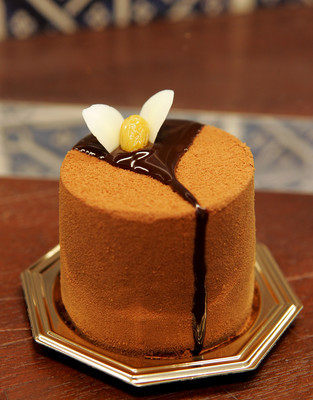Sweet Success
Life is sweet for Fredéric Robert.
Actually, it's savory, too. But it's Robert's passion for pastry and chocolates -- that would be creating them, not eating them -- that dominates much of his life and has brought him acclaim here and abroad.
Robert is executive pastry chef at Wynn Las Vegas, where the resort's guests and visitors are most familiar with his work through the shops Sugar & Ice and Chocolat. But Robert also represented his adopted hometown in this year's James Beard Foundation awards, for his "Grand Livre de Cuisine: Alain Ducasse's Desserts and Pastries," which won in the Cooking From a Professional Point of View category. Mitchell Davis, vice president of the James Beard Foundation in New York, said the award is "a seal of approval from your peers ... it puts you into an elite club."
Robert's name is emblazoned on the book's cover as the author, so why is Ducasse's name part of the title? Because Robert knew his experience with a lion of the culinary world was a compelling story, which he would tell mostly through the 250 recipes in his book. And, Ducasse said in an e-mail, " 'The Grand Livre de Cuisine: Alain Ducasse's Desserts and Pastries' relays the joy and appreciation for the pastry arts that we share."
It's an association that was formative for Robert.
"For 25 years, I worked with Alain Ducasse," Robert, 48, said during a recent interview. "It's a long, long story. The feeling of Alain Ducasse is so different."
Ah, but the feeling of Frederic Robert is different, too.
"He's a fabulous professional, incredible guy," said Marc Poidevin, catering and special-events chef at Wynn Las Vegas, who said he has known Robert for many years.
"Extremely artistic," Poidevin added. "He can do anything -- he can do sugar, he can do chocolate."
Which is why Wynn Resorts recruited Robert for the hotel's opening four years ago -- and why, after so many years, he finally was moved to leave Ducasse's organization.
"After 25 years with the same chef, I'm very happy, but in your life you have one or two great opportunities," Robert said.
His expertise was hard-earned, and rather circuitous. He summarizes his early goals in the foreword to his book:
"My father wanted me to go to cooking school, to learn how to master technology rather than waste my time and energy in haphazard apprenticeships. It is for this reason that, very early on, I entered the kitchen, whereas my dreams would have carried me more willingly toward the bakery."
And it's no wonder he stayed so long with Ducasse, and is so inspired by him. After Robert graduated from culinary school in 1978, he worked for several years for chef Alain Chapel, and "I saw a young chef whose name is Alain Ducasse."
Robert was inspired by Ducasse, by his charisma but more importantly by "the vision of the food, the experience."
Robert told Chapel he wanted to move to the pastry kitchen, and someday work for Ducasse. Chapel wanted him to stay where he was.
In 1981, Robert moved to the restaurant of Chef Louis Outhier near Cannes, France, and again encountered Ducasse.
"This is," Robert said in the foreword, "the true beginning of the story."
"He gave me a chance," he said in the interview. "He gave a chance to young people."
Robert worked for a year in the kitchen at Ducasse's Juana, near Nice on the French Riviera. Then he asked to move to the pastry kitchen, and this time his interest was rewarded. And during the five years Robert worked at Juana, he gained expertise not only from Ducasse but also in a series of training courses.
There was a season with the great Gaston Lenôtre in Paris, for intense study in basic and classic pastry. A season with a maker of nougats and confections, one with a maker of chocolates, one to concentrate on ice cream flavors and textures, one with baker Jean-Paul Veziano in Antibes, France, "for the love of the good and the beautiful," and one in Vienna, where he learned about Viennese pastries -- and also began an enlightenment about ingredients that had heretofore been foreign to him.
"It opened my eyes to be curious," Robert said.
He went to Italy, where he met the "king of pasta."
"I think I make the best dough," he said, but, "oh, he does it better."
He also learned a lot from Ducasse.
"He brought a lot for me," Robert said. "He pushed everything, but was great for me."
"Fredéric entered the kitchen as a cook and I encouraged him to move toward the world of pastry," Ducasse said. "This duality allowed him to combine discipline and technique from pastry with a subtle and spontaneous spirt from his previous profession. He put together the two with passion and skill without ever drastically changing the tone between the art of savory and sweet cuisine."
Robert stayed with Ducasse, moving to Louis XV in Monaco, then Paris, and eventually directed all of Ducasse's restaurant openings and taught at the master's culinary academy. He wrote the original French version of "Grand Livre," named Best Dessert Book in the World by The Gourmand World Cookbook Awards in 2002.
And then the Wynn opportunity arose.
"I say, 'Why not?' " Robert says now.
From Ducasse and the other pastry chefs who mentored him, Robert took this most important point: "Choose the best product and keep (it) natural." His goal today, he said, is simple: "to make something fresh."
And he has put his own touches on American favorites. A blueberry muffin, for example, will contain only fresh blueberries and be "lighter, more elegant" than is common. Bread pudding on the Wynn buffet is made with croissants and briôche.
"I try to use my technique," he said. "Every time you make a recipe, you try to make the best. You try to follow the life, the time, and make something good.
"I don't understand why so many young guys train so long for hotels that buy everything. Business is nice, but quality of life, respect is more important."
Poidevin said Robert shatters the stereotype of the pastry that's fancy but without flavor.
"Usually when they're grandiose, there's nothing to eat," he said. "He's more about ingredients, flavors, using the best product. He's of the Ducasse school -- product freshness, texture, flavors. And a mix of flavors inside the dessert."
All of that's obvious in the book, which includes not only recipes and color photos but, in some cases, a diagram of how to put the dessert together. Chapters cover plated desserts, ice cream and sundaes, classic French and foreign desserts, breads, petits-fours, confections and chocolates, and entremets, which includes elaborate desserts. Some of them, Robert concedes, are for the professional, but others are 'for the guy who works in the kitchen.' "
He did the translation, he said, because the French version was a success, and because customers at Alain Ducasse at the Essex House in New York had said they would like to attempt some of the recipes but couldn't because they didn't speak French.
"USA is a big part of Ducasse," Robert said.
And a big part of Robert, too. His next step: to travel across this country and learn, particularly about crops and artisanal producers.
"I'm very curious about everything," Robert said. "Some artisans are very good.
"There are good cherries, good peaches. I need to discover this, get a good vision of the USA."

























